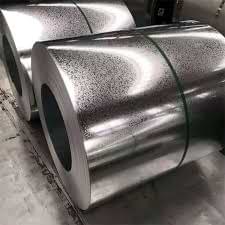
Knowing the average coil weight helps buyers estimate logistics costs, optimize transport, and plan storage capacity. In this article, we’ll explain the average weight of different steel coils, the formula to calculate coil weight, and practical examples.
A steel coil is a long, continuous strip of steel that has been rolled into a coil shape for easy storage, handling, and transportation. Coils can be produced from:
Hot Rolled Steel (HRC) – thicker, used in heavy industry.
Cold Rolled Steel (CRC) – thinner, smooth finish for appliances.
Galvanized Steel (GI/GL) – zinc or aluminum-zinc coated.
Color-Coated Steel (PPGI/PPGL) – pre-painted galvanized or galvalume steel.
Each type of coil has different thickness, width, and length — which directly impacts its average weight.
The weight of a steel coil is determined by its dimensions and density of steel. The standard density of steel is 7.85 g/cm³ (or 7,850 kg/m³).
Formula:
Alternatively, mills calculate by outer and inner diameters:
Where:
= Outer radius of coil
= Inner radius (usually 508 mm or 610 mm standard)
Because coils vary widely, here are the typical weight ranges for common coil types in 2025:
Thickness: 2.0 – 6.0 mm
Width: 1,200 – 1,500 mm
Average Weight: 20 – 30 tons per coil
Usage: Shipbuilding, heavy machinery, infrastructure.
Thickness: 0.3 – 3.0 mm
Width: 1,000 – 1,250 mm
Average Weight: 10 – 25 tons per coil
Usage: Automotive panels, appliances, precision engineering.
Thickness: 0.2 – 2.0 mm
Width: 914 – 1,250 mm
Average Weight: 5 – 20 tons per coil
Usage: Roofing, wall cladding, pipes, outdoor structures.
Thickness: 0.2 – 1.2 mm
Width: 914 – 1,250 mm
Average Weight: 3 – 10 tons per coil
Usage: Roofing sheets, siding, decorative applications.
A quick way to estimate weight is to remember:
1 mm thickness, 1,000 mm width coil weighs ≈ 7.85 kg per meter length.
For example:
0.5 mm thickness, 1,000 m length → ≈ 3.9 tons
1.0 mm thickness, 1,000 m length → ≈ 7.85 tons
Most industrial mills wind coils until they reach 10–25 tons for economic shipping. Lighter coils (3–10 tons) are preferred for color-coated coils since customers often need easier handling.
Most steel mills follow international standards for coil packaging and shipping weights:
Export Coils (for containers): 3 – 15 tons (easier for forklift handling)
Bulk Shipping Coils (breakbulk vessels): 20 – 30 tons per coil
Mini Coils: 1 – 5 tons, usually cut from larger coils for small orders
This flexibility allows buyers in Europe, the USA, Asia, and Africa to choose coil sizes that fit transport restrictions and equipment capabilities.
Understanding coil weight is not just about logistics — it has a direct impact on project planning and cost efficiency.
Truckload or container capacity depends on coil weight.
A 20-ton coil may require special handling, while 5-ton coils fit standard forklifts.
Heavy coils need cranes, coil cars, or C-hooks.
Light coils can be managed with forklifts.
Large coils (20+ tons) reduce downtime for coil changes.
Smaller coils offer flexibility for varied production runs.
Many countries set weight limits for port handling.
Exporters often customize coil weights for specific markets.
Let’s calculate a few practical examples:
Thickness: 3.0 mm
Width: 1,250 mm
Length: 1,200 m
Weight = 1.25 × 0.003 × 1,200 × 7,850 = 35,325 kg (35.3 tons)
Thickness: 0.5 mm
Width: 1,000 mm
Length: 800 m
Weight = 1.0 × 0.0005 × 800 × 7,850 = 3,140 kg (3.14 tons)
Thickness: 0.4 mm
Width: 1,200 mm
Length: 1,200 m
Weight = 1.2 × 0.0004 × 1,200 × 7,850 = 4,521 kg (4.52 tons)
In 2025, steel mills continue to produce large coils (20–30 tons) for bulk buyers, while lightweight coils (3–10 tons) are increasingly popular in Europe and North America due to transport restrictions and smaller processing lines.
Asia (China, India, Vietnam): 15–25 ton coils common for export.
Europe: 5–15 ton coils preferred for roofing and construction.
USA: Mix of 10–20 ton coils depending on end-user industry.
Middle East & Africa: 5–15 ton coils for construction imports.
So, what is the average weight of a steel coil?
Hot Rolled Coils: 20–30 tons
Cold Rolled Coils: 10–25 tons
Galvanized Coils: 5–20 tons
Color-Coated Coils (PPGI/PPGL): 3–10 tons
Ultimately, the coil weight depends on thickness, width, and order specifications. For buyers, the key is to balance handling efficiency with transport costs — larger coils save time in production, while smaller coils are easier to move and store.
| Categories: | Items for Sale / Tools |
| Phone: | +86 135 7205 0608 |
| Address: | Building 1, No. 5218, Yunchuan Road, Baoshan District, Shanghai, China |
| Website: | View our site |
| Email: | order@midweststeelsupply.org |